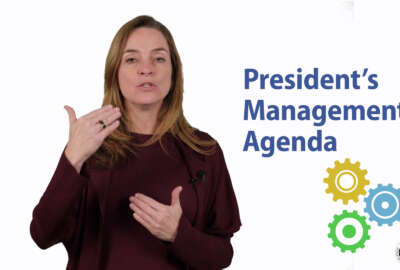
5 things we learned from the 2019 Federal Employee Viewpoint Survey
Federal News Network took a closer look at employee perceptions of performance management techniques, the government shutdown and telework, among other topics in...
The Trump administration has used the Federal Employee Viewpoint Survey as a treasure trove of data to inform, at least in part, planned changes to the civil service.
There are a lot of ways to splice and dice the data. The Office of Personnel Management itself, which administers the survey, provides departments and individual agency offices with more than 30,000 reports detailing their results.
A quick glance at the results shows employee engagement across government remained stable in 2019 with a score of 68%, the same as the previous year.
Here are five additional observations from the 2019 Federal Employee Viewpoint Survey.
Why participation matters
OPM, individual agencies and the Partnership for Public Service have pointed to one question on the FEVS as the most telling of actual employee engagement: “I believe the results of this survey will be used to make their agencies better places to work.”
This question, engagement experts have said, shows employees have confidence in their agency’s leadership to listen to their feedback and then act on it.
If employees see their agency’s commitment to their feedback, it often encourages them to continue sharing their thoughts and opinions.
In 2019, 41% of respondents said they believed the results of this survey would be used to make their agencies better places to work.
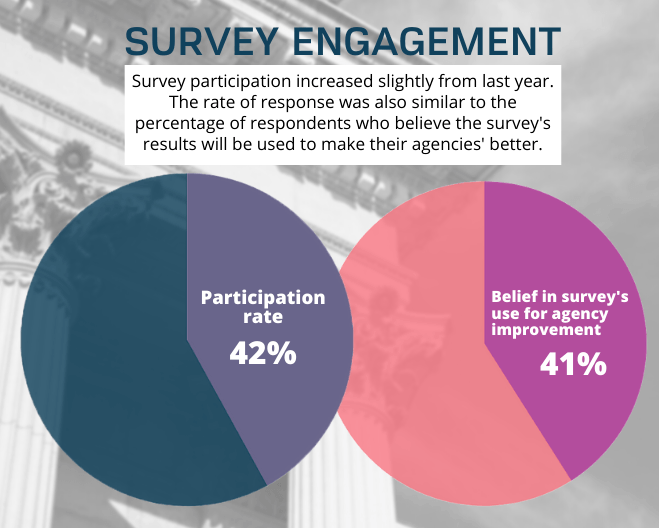
“This [survey] is no small thing. It’s going to take 15 minutes of your busy, busy day,” Kim Wells, acting director of OPM’s Office of Strategy and Innovation, told reporters earlier this week. “You have to remember to do it, and then you’re going to get bombarded by a lot of reminders, and then you finally sit down and answer with responses. If you get radio silence from your leadership that’s not really going to encourage you to continue on next year.”
The participation rate did go up slightly this year. A total 615,295 employees, or 42.6% of the federal workforce, responded this year. By comparison, a little less than 41% of the workforce responded to the 2018 survey.
Those figures don’t include the Department of Veterans Affairs, the second largest federal agency. VA conducts its own all-employee survey, which includes some of the same questions included on the FEVS.
Nearly 66% of the VA workforce, or 256,807 employees, responded to the department’s own survey. Had those employees been included within the FEVS participation total, the governmentwide response rate likely would have been higher.
Small performance improvements
The 2019 FEVS shows small, incremental bumps in employees’ perceptions of their pay, rewards, promotions and other performance management indicators.
Performance management has been a key priority, if not the key priority for the Trump administration’s ongoing efforts to modernize the federal workforce.
And the administration has often cited FEVS data in justifying its proposals to, for example, freeze across-the-board pay raises for federal employees or instruct agencies to review and streamline their performance management and disciplinary policies.
The Trump administration will likely continue to cite these particular results as both a sign that its policy changes are working — and an indication that more needs to be done.
“Some of the 2019 results raise concerns,” Dale Cabaniss, the OPM director, said in a message accompanying the FEVS report. “Respondents continue a five-year trend of reporting concerns about the manner in which poor performance is addressed and, in particular, the perceived lack of proper application of merit principles to promotion and reward decisions.”
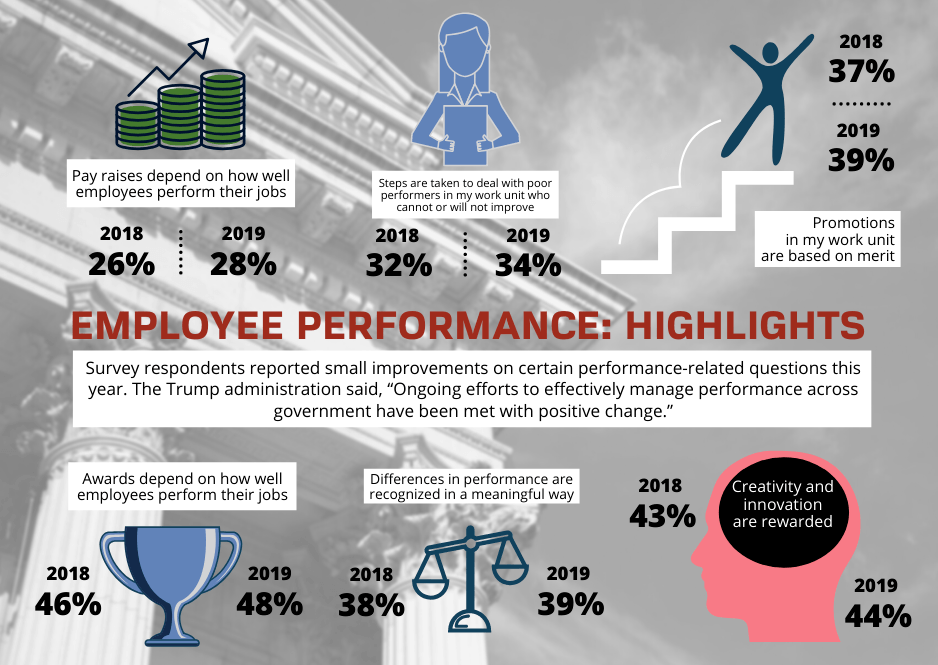
An injunction on the president’s three workforce executive orders was still in place while OPM administered the 2019 FEVS, so the policies in the EOs technically aren’t at play here.
But the EOs have been part of the conversation for more than a year, and federal employee unions have said they’ve seen agencies attempt to implement pieces of them throughout the collective bargaining process.
Still, employees have a relatively negative perception of poor performers within their agencies. When asked for the first time this year what steps they believed their agencies took to manage poor performers, the feedback is telling.
A clear majority, or 56% of respondents, said poor performers continue to remain in their work units and continue to under-perform, while 17% said poor performers stay in the work unit and do manage to improve.
Roughly 8% said poor performers are removed or transferred, and just 2% said these poor performers leave. About 17% said there are no poor performers in their work units.
Supervisors, feedback earn slightly better scores
Based on the recent FEVS data, federal employees had slightly better perceptions of their interactions with agency supervisors in 2019.
Supervisors across the board earned a slightly better score of 76% in 2019, compared with 75% during the previous year.
Performance, and the efforts immediate supervisors make to ensure their employees can succeed and improve, have direct ties to engagement, OPM said.
“Are there things that workplaces can do to support that diligence and effort that is ultimately performance?” Wells said. “We find that there are a number of things that we can do. We can make sure that we have good relationships with supervisors, for example.”
Employees at small and medium agencies have the best perceptions of their immediate supervisors, according to the data.
But more specifically, the FEVS data shows employees are feeling slightly better about the opportunities they have within their agencies for training or new kinds of work altogether.
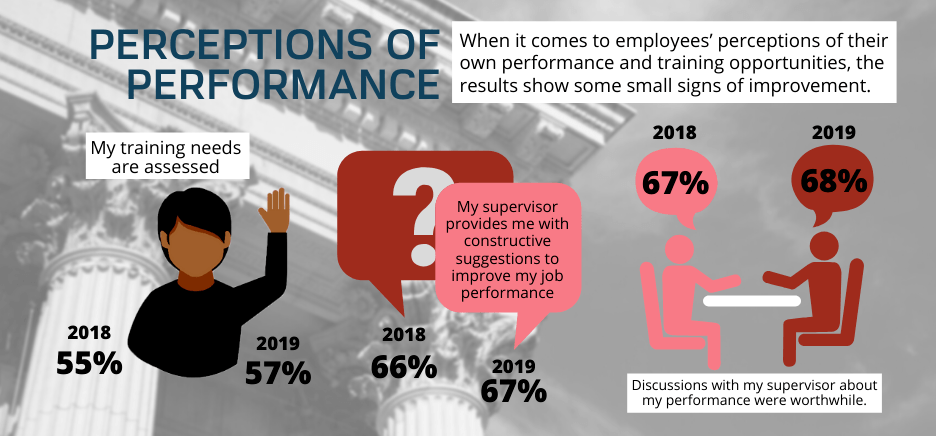
Shutdown isn’t driving employees out the door
OPM added new questions to the FEVS about the partial government shutdown and its impact on the federal workforce for the first time this year at the request of several agencies.
But OPM said it too was interested in such data, because it only had past assumptions about the shutdown’s impact on employee morale and satisfaction.
Though employees impacted by the partial government shutdown said the most recent lapse delayed work, reduced customer service and prompted them to miss deadlines, the experience doesn’t appear to be driving many out the door.
A small proportion of FEVS respondents, just 2%, said the recent partial shutdown had prompted them to look for another job. The lapse was a factor for another 8% of employees who said they were looking for another job.
In total, about 30% of the workforce said they were looking for another job.

Feds satisfied with telework
Federal employees appear largely satisfied with their agency’s telework program, if they’re eligible to use it.
Though several agencies have made changes to their telework policies over the past year, the FEVS data shows no meaningful change in employee participation from 2018 to 2019.
Most federal employees telework sporadically as an unexpected event arises, or they telework one or two days a week, according to the FEVS data.
What the data does show, however, is that participating employees are largely satisfied with their telework programs.
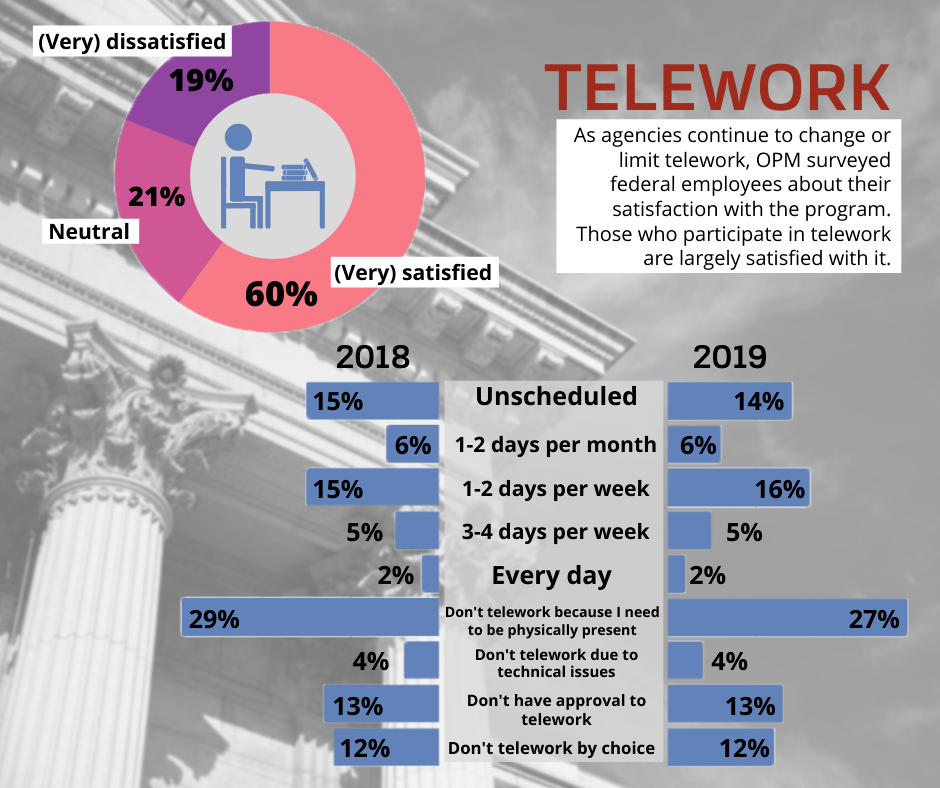
The Agriculture and Education Departments and at least one office within the Department of Health and Human Services have limited telework to one day a week for their employees in recent months. The Social Security Administration recently eliminated telework for its operations employees.
Graphics by Amelia Brust
Copyright © 2025 Federal News Network. All rights reserved. This website is not intended for users located within the European Economic Area.
Nicole Ogrysko is a reporter for Federal News Network focusing on the federal workforce and federal pay and benefits.
Follow @nogryskoWFED
Related Stories





